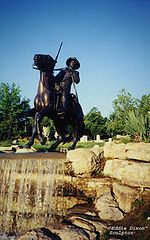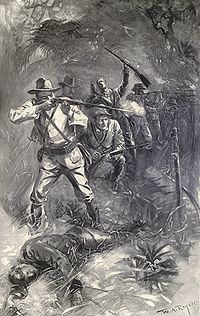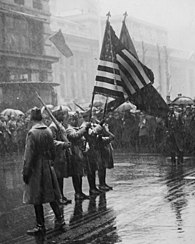John Bigelow Jr.
He was the subject of many articles on military frontier life in Outing Magazine published by his brother Poultney Bigelow and with sketches drawn in the field by the then young and obscure Frederic Remington.
[1] On April 28, 1883 he married Mary Dallam (July 24, 1858 Baltimore, Maryland – about 1941) and they had one son and several daughters of which only one survived him.
Their son, Captain Braxton Bigelow was killed in action in 1917 while serving with the British Royal Engineers near Loos.
While at the Military Academy Bigelow met Henry Ossian Flipper a classmate who had been born a slave.
Bigelow, later with the 10th Cavalry, wrote historical sketches for these Buffalo Soldiers which are still used today as a reference.
[2] On December 14, 1877, the young Bigelow reported for duty at Fort Duncan in West Texas.
While Bigelow never became proficient in his sketches, his journals became the basis of serial articles on the hunt for Geronimo for his brother's Outing magazine.
Remington added a series of freelance sketches for the magazine that included his new friend, John Bigelow.
[1] Bigelow, now tough and leaner in stature, with a regimental approved mustache, from his tenure on the frontier had become a teacher to Remington regarding the cavalry and the tools of the trade.
On at least two occasions his "notoriety" caused him delay in returning to his command because of the "need" for him to attend a party while in transit at some frontier posting.
Bigelow and his troop were part of the escort taking Geronimo to the railroad station for his imprisonment back east.
The first of these were the Battle of Las Guasimas on June 24, 1898, where Bigelow and the 10th Cavalry saved a portion of the Rough Riders from annihilation when their lead companies were ambushed and pinned down.
This was where Harper's Weekly war correspondent Frederic Remington experienced the true horror of combat and heard the whistle of bullets near his head.
En route back to the company, Ord passed by the different units including Roosevelt's Rough Riders and asked them to support the regulars when they went up the hill.
[1] Captain Bigelow led his soldiers up the steep slopes to the heights of San Juan Hill.
Just past the midway point he was hit in quick succession by three Spanish bullets which caused him to fall.
Several soldiers present reported that he encouraged them with, "Men, don't stop for me, just keep up the charge until you get to the top of the hill."
[1] Bigelow's second in command, Jules Ord, reached the top and began directing supporting fire when he was hit in the throat and mortally wounded.
[7] Returning to the United States, he was shuffled from one fort to another each further westward until he reached the Presidio of San Francisco in later part of 1903.
In early 1904, Bigelow ordered an arboretum on the South Fork of the Merced then in the southern section of Yosemite National Park.
The NPS cites a 1904 report, where Bigelow declared the arboretum "To provide a great museum of nature for the general public free of cost ..." Unfortunately, the forces of developers, miners and greed cut the boundaries of Yosemite in 1905 and the arboretum was nearly destroyed.
Seeing the winds of change shrinking Yosemite and Claiming ill health, he retired from the army in late September 1904.
His unintentional snubbing of Teddy Roosevelt in 1899 and undaunted support for black troops continued to prevent him from serving his country like his father.
[1] In 1914 when war broke out in Europe, he redoubled his effort to join the diplomatic corps and when that failed, he offered to serve in any capacity.
As America was dragged into World War I, Bigelow was recalled to active duty as a lieutenant colonel.
Again he was denied an active command and served at Rutgers and in the War Department's Historical Branch until his release in the later part of 1919.
On February 29, 1936 with war looming once again in Europe he died at home in Washington, D. C.[1] During his military career, Bigelow earned the Silver Star while attacking up San Juan Hill in Cuba.












